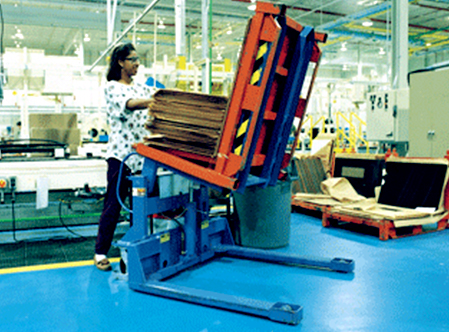Cardboard and Dunnage Tilter

Introduction
Workstation tilter decreases work-related back injuries associated with stacking and packaging sheets of cardboard.
Project Challenge
A customer was challenged by their safety department to reduce employee exposure to lower back injury due to excessive bending and reaching during the manual material handling tasks associated with stacking, transporting, and packaging sheets of cardboard dunnage used in the manufacturing processes.
The optimum solution would need to solve the following workstation challenges:
- Must be able to easily transport a load of cardboard to packaging area – or between work stations.
- Must have an on-board power supply, power utility hook-ups/plug-ins not available at all work stations.
- Must reduce bending and reaching motions during manual loading.
Our Solution
Upon review of the customer’s application and performance requirements from the safety and industrial engineers, the Autoquip design team recommended a portable hydraulic tilting solution from their line of AutoTilt portable tilters.
The design features of this family of tilters closely matched all the customer’s performance requirements:
- Easily transported with an operator push handle, industrial casters with wheel locks, and a foot-operated floor lock to maximize load stability during manual build-up/break-down tasks.
- On-board 12VDC battery supply and controls.
- 89 degree high-hinge tilting motion to raise the load into the employee’s ergonomic “power zone” during loading & unloading.
In addition, Autoquip also recommended on optional on-board quick-charge battery charger and the “straddle” placement of the tilter’s floor channels and forks to provide maximum side-to-side tilter stability.
Specifications for this Tilter Application:
Tilter Capacity: 2,000 lbs
Degrees of Tilt: 89 degrees
Power Supply: 12VDC via on-board battery
Actuation: Hydraulic
The Results
Through the addition of a portable hydraulic tilter, the tasks associated with collection and packaging of cardboard/dunnage are now performed in a more ergonomic manner, decreasing work-related injuries and improving productivity.